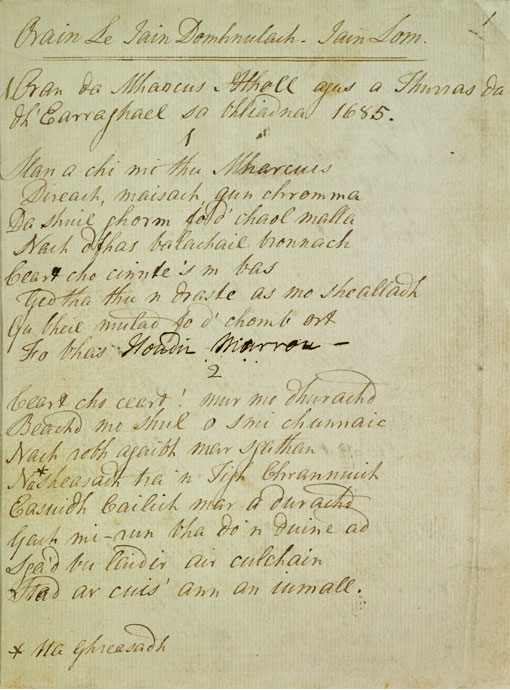Sìleas na Ceapaich ca.1660 - 1729
Sìleas Nighean Mhic Raghnaill, or na Ceapaich (of Keppoch) was born around 1660, allegedly at Bohuntin, two miles or so up Glen Roy from Keppoch in Inverness-shire. Her father, Gilleasbaig, Mac Mhic Raghnaill.
Raghnaill, was the 15th chief of the MacDonalds of Keppoch, and was himself a poet. Her standing as a chief’s daughter was, admittedly, less impressive than it once might have been but nevertheless she was a woman of some social standing.
She spent much of her life in Banffshire as the wife of Alexander Gordon of Camdell , hereditary factor to the Duke of Gordon. This advantageous marriage ensured that Sìleas was fairly well off. Indeed, from the early 1700s she and her husband were the proprietors of Beldorney Castle, located at the border of Banffshire and Aberdeenshire. From various sources we gather that she had five sons and at least three daughters.
Belonging to both a traditional Gaelic ruling family and a powerful North-Eastern family meant that during the period she was composing her poems, Sìleas was a woman of some status. She was much-admired as a poet. Most, if not all, of her works were preserved within the oral tradition and her compositions in vernacular Scottish Gaelic ranged from elegy to politics and religion. Within the Gaelic tradition her images were both familiar and traditionally appropriate.
Her religious poems reflect the Roman Catholic faith that she adhered to. In her political poems, she emphasizes the achievements of various branches of Clan Donald, an indication that she intended her poetry mainly for a MacDonald audience.
She was also a woman with fierce ideals who had strong Jacobite sympathies which reflects the attitude of the majority of her Gaelic contemporaries. In the song ‘Là Sliabh an t-Siorraim’ she sings of the popular expectation of the arrival of James Stuart, the Old Pretender, the indecisive batte of Sheriffmuir and the state of uneasy anticipation between the battle and the end of the 1715 Rising.
Her style of composing was fairly structured and formal, and she is probably best known for her elegant lament for the chief of the MacDonalds of Glengarry, 'Alasdair a Gleanna Garadh' . It’s possible that the depth of feeling shown in the lament is a reflection of her grief for her own husband and daughter, both of whom Sìleas had lost by the time she composed it in 1721.
Although the date of her death is unclear, we know that she was living in 1724. The fact that Sìleas’ work is so well known in the Gaelic world today is testimony to the important role some politically- aware women had during a particularly turbulent time in Scottish history.
